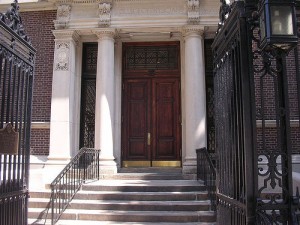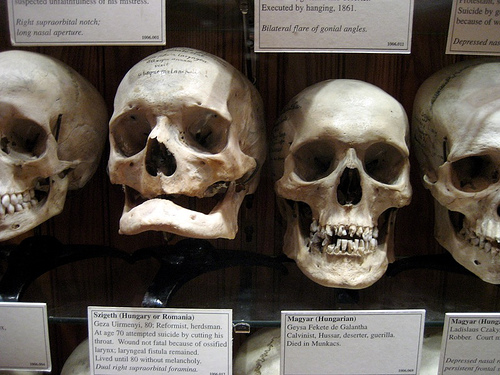
The entrance to the College of Physicians of Philadelphia, which houses the Mütter Museum.
It has been something of a guilty pleasure, but I have always loved off-beat museums. Here in Philadelphia, we have something of an embarrassment of riches: the Mummers Museum, which the Fancy Brigades keep lively on New Year’s Day; the cabinet of curiosities that is the Wagner Institute of Science; and there is even the Insectarium!, an all-bug museum with the largest collection of insects in America. But, the place every visiting tourist must not miss is the Mütter Museum at the College of Physicians of Philadelphia. Below is my love-letter to this house of wonders.

Making friends at the Mütter Museum: this guy's tattoos were based on an artifact in the museum. Photo courtesy of Rebecca Fuller.
I was never that concerned with the fact that my childhood experience did not include being a Boy Scout. Really, the pinewood derbies and jamborees just never sounded that appealing. That said, it would have been great to spend just one night in a sleeping bag, looking up from the floor at the bones spotlighted in the dark Dinosaur Room, during one of those nights at the museum. These days, though, I would totally trade in the Jurassic bones for the creepiness of the 139 human skulls peering from the shelves of the Hyrtl collection inside the Mütter Museum.

Just a few examples of the Hyrtal Skull Collection: 139 human skulls.
Even many locals are unaware of the oddities that lie behind the grand façade as they drive up 22nd Street on their way to Trader Joe’s. It’s a place where former employees have literally left pieces of themselves behind. Walking into the lobby of the oldest medical organization transports you into another time; it’s a cold, dimly lit, unsettling setting. As part of The College of Physicians of Philadelphia, recently dubbed the “Birthplace of American Medicine,” the Museum’s mission is first and foremost to be a resource to the aspiring physician, but their most vocal fans love the shock of the medical abnormalities. Many in the “oddities” subculture miscategorize the Mütter, grouping it with vaudevilles like P.T. Barnum’s sideshows and The Bunny Museum in Pasadena, when in fact it is more in line with the institutional purviews of David Wilson’s The Museum of Jurassic Technology or Corinne May Botz’s The Nutshell Studies of Unexplained Death. Yet as striking as they might be, every object in the vault is either cast from parts or actual specimens of the human body preserved in formaldehyde—far more ghastly then any Damien Hirst shark, cow, or sheep.
While the highlights of the 25,000-item collection are far too numerous to list here, some of the crowd pleasers include a malignant tumor removed from President Grover Cleveland, John Wilkes Booth’s thorax, a nine-foot long human colon, and the petrified body of the Soap Lady—a mummified corpse that turned to, well, soap. According to the Museum’s director, Dr. Robert Hicks, the most frightening, enthralling artifact in the vault is the skeleton of Harry Eastlack, a man who lived with Fibrodysplasia Ossificans Progressiva (FOP) until he died at the age of thirty-nine. His is the only complete skeleton of someone whose tissues and muscles petrified, or turned to bone. According to Dr. Hicks, “he is the most horrific thing we’ve got.” If you have always been enthusiastic about malformed human remains, but prefer some sort of context, recent exhibitions that may interest you include: When the Patient is the President, Emerging Infectious Diseases, and Medical Adventures on the Lewis & Clark Trail. The controversial Body Worlds exhibition may have billed itself as “the first exhibition to display “objects” from a body donation program,” but that’s just semantics. The Mütter is truly the original.
It seems highly improbable that I’ll have an opportunity anytime soon to spend the night with Chang and Eng, but hey, you never know. Perhaps if the economy keeps tumbling, I’ll pick up a moonlighting gig there as a night watchman. Then, I could live vicariously through my future museum-loving children who wouldn’t have to deal with scout oaths, merit badges, or wearing all of that olive and khaki. I would just bring them along for Take Your Child To Work Day.




Pingback: New Guest Blogger: Quinn Latimer | Art21 Blog